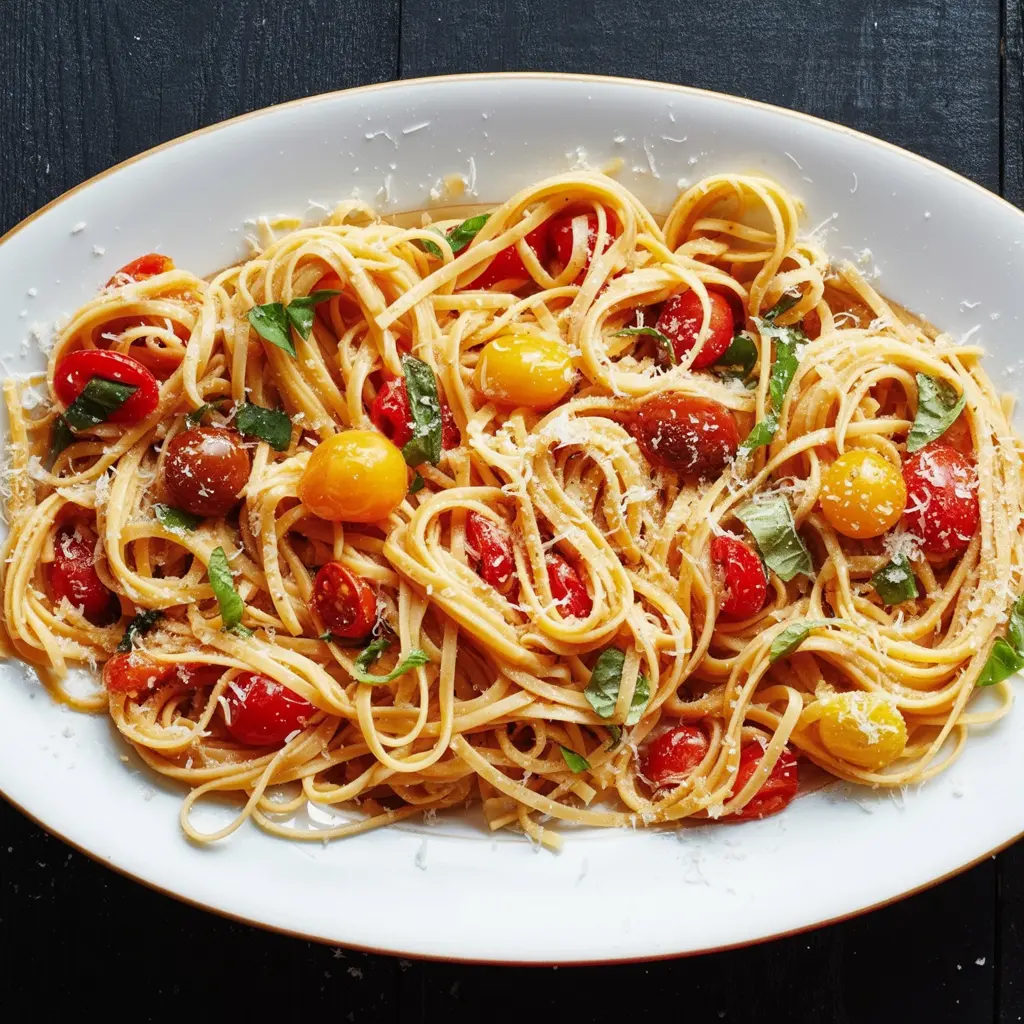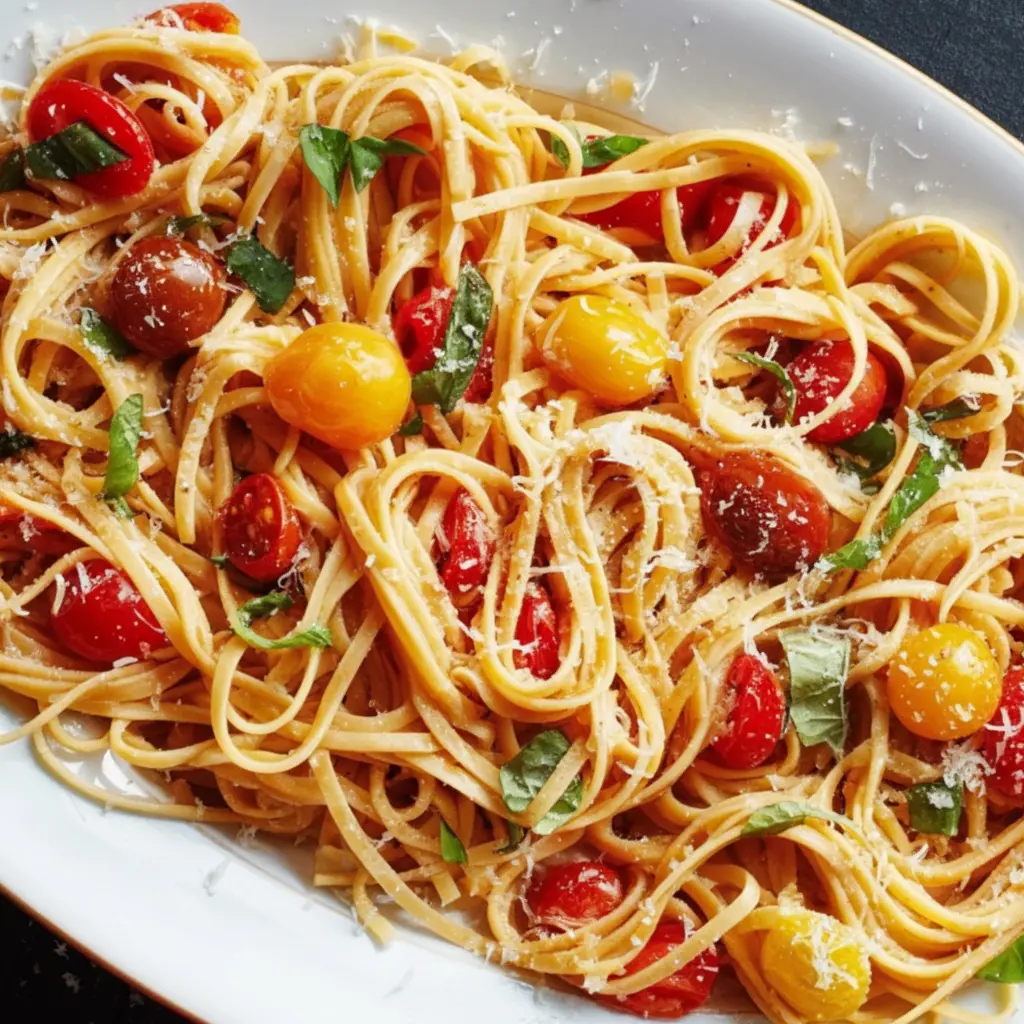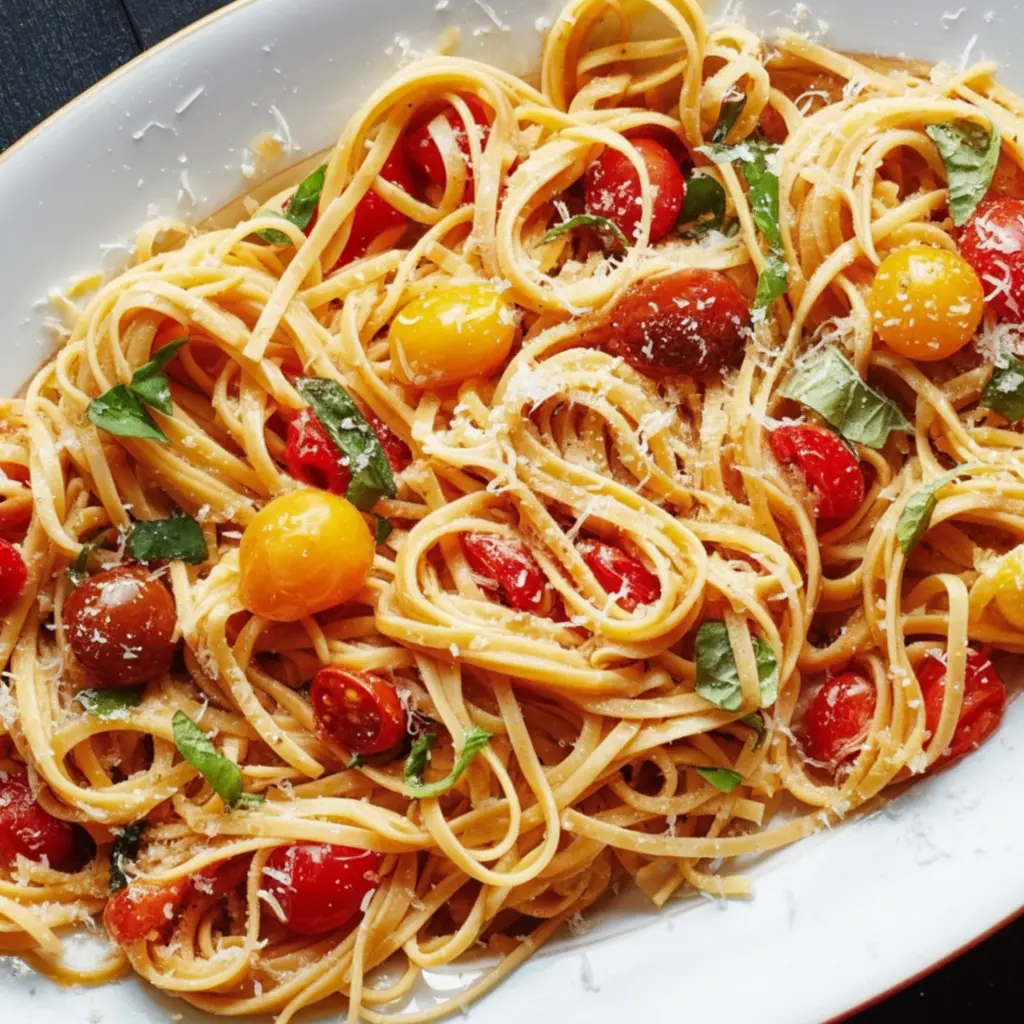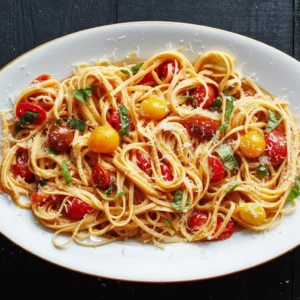Some recipes sneak into your life quietly and end up staying forever. This cherry tomato pasta is one of those for me. I first made it on a warm August evening when I was staring into a fridge full of not much—just a bowl of soft, sun-warmed cherry tomatoes from the garden, a lone shallot, and half a box of spaghetti in the pantry. I had just come home from a long day of wrangling two cranky kids and a temperamental oven (which later gave out entirely during a Thanksgiving turkey roast—but that’s another story). I needed something that wasn’t fussy, something I could make with one hand while holding a baby in the other, and something that tasted like I had put in far more effort than I actually had.
That night, I heated some olive oil, tossed in the shallots, then the tomatoes, and let them do their thing. I didn’t know it then, but I had stumbled into what would become one of my most reliable, repeatable, deeply satisfying meals. Cherry tomato pasta is humble, but when it’s done right, it tastes like summer in a bowl. Sweet, tangy, rich—but still light enough that you never feel weighed down. It’s the kind of dish that reminds you why you fell in love with cooking in the first place.

Why You’ll Love This Recipe:
- Ready in under 30 minutes, start to finish
- Uses simple, pantry and garden staples
- Sweet, bright flavor from just a few ingredients
- Easily adaptable to what you have on hand
- Feels elegant but requires minimal effort
Ingredients You’ll Need:
Spaghetti or linguine – I typically reach for spaghetti, but I’ve used everything from bucatini to rigatoni, depending on what’s open. Long pasta really lets the tomato sauce cling beautifully, but don’t be afraid to experiment.
Cherry tomatoes (about 1.5 pints) – Use the ripest you can find. In the summer, I use a mix from the garden—Sun Golds, Sweet 100s, and whatever else decides to grow. Off-season, I go for store-bought grape tomatoes and roast them just a touch longer to coax out that sweetness.
Shallot or small red onion – Shallots melt into the sauce a little more delicately, but a red onion gives it a bit more bite, which I don’t mind at all. I’ve even used a yellow onion in a pinch.
Garlic (3–4 cloves) – I’m never shy with garlic here. Slice it thin for a milder flavor, or mince it if you want a bit more punch.
Olive oil – Use the good one if you can, since it’s a main flavor player. I drizzle a bit more at the end too, for richness.
Salt and freshly cracked pepper – Be generous. The salt brings out the sweetness in the tomatoes, and the pepper adds depth.
Red pepper flakes – Optional, but I always add a pinch. Just enough for warmth, not heat.
Fresh basil – Essential in my book. Tear it with your hands so it doesn’t bruise. If you’ve got parsley, you can mix a little in, too.
Parmesan cheese (optional, but encouraged) – Grate it fresh, right over the warm pasta. It adds that salty umami layer that ties everything together.
How to Make It (Step-by-Step Instructions):
Start by bringing a large pot of salted water to a boil. I’ve learned the hard way—don’t forget the salt here. It’s your first chance to season the pasta itself, and it makes all the difference. While the water heats, grab your largest skillet or sauté pan and set it over medium heat. Add a generous glug of olive oil—enough to coat the bottom of the pan—and let it shimmer.
Toss in your sliced shallots or onions and let them soften, stirring occasionally. You want them translucent, not browned. This takes about 3–5 minutes. Then in goes the garlic. I always lower the heat a bit here—burnt garlic is bitter and will overpower the delicate tomato sauce. Let it sizzle just until fragrant.
Add all your cherry tomatoes at once. They’ll hiss and pop as they hit the oil—don’t be alarmed. That sound means flavor is building. Stir to coat them in the oil, then let them cook down for about 10–12 minutes. Some will burst on their own, which is exactly what you want. I help a few along with the back of a wooden spoon, but not all—you want some to stay intact for texture.
While the tomatoes cook, drop your pasta into the boiling water and cook until just shy of al dente. I usually shave off about a minute from the box instructions. Before you drain it, scoop out about a cup of that starchy pasta water—it’s liquid gold and helps the sauce cling.
Back to the tomatoes: once they’re jammy and saucy, season them well with salt, black pepper, and a pinch of red pepper flakes. Stir in about ¼ cup of the reserved pasta water to start, then add the drained pasta directly into the skillet. Toss everything together over low heat until the sauce hugs the noodles. Add more pasta water if needed—it should be glossy and silky, not dry.
Turn off the heat, tear in a handful of fresh basil, and if you’re feeling indulgent, drizzle a bit more olive oil over the top. Serve immediately, with grated Parmesan passed at the table.

Expert Tips for the Best Results:
What I’ve learned after making this dish more times than I can count is that patience is everything when it comes to the tomatoes. Don’t rush them—let them soften and collapse at their own pace, and resist the urge to stir too often. The sauce benefits from a bit of caramelization on the bottom of the pan, which adds an extra layer of flavor. Always reserve more pasta water than you think you’ll need—it’s the key to achieving that restaurant-quality sheen. And finally, season at every step. Under-seasoned pasta is like flat soda—fine, but forgettable.
Variations & Substitutions:
This recipe has survived countless “whatever’s in the fridge” nights. I’ve stirred in a spoonful of tomato paste when my cherry tomatoes weren’t sweet enough. I’ve added a splash of white wine or a pat of butter for richness. I’ve even tossed in spinach or arugula right at the end for a green twist. Once, when I was out of pasta entirely (how?), I used farro and made it more of a warm salad—it wasn’t the same, but it was still delicious. The recipe is flexible, forgiving, and always good company.
Serving Suggestions:
I love serving this pasta with a simple green salad and maybe a crusty piece of sourdough if we have it. A chilled glass of white wine never hurts either. It’s light enough for a summer lunch but satisfying enough for a weeknight dinner when you need something comforting and quick. It also makes a lovely starter for a dinner party—just serve in smaller portions with plenty of herbs on top.
Storage & Reheating Instructions:
This pasta keeps surprisingly well. I store leftovers in a glass container with a tight lid and eat them within two days. Reheat gently on the stove with a splash of water or olive oil to loosen the sauce—it’ll never be quite as silky as the first time, but it still tastes fantastic. I’ve also eaten it cold, straight from the fridge, and I’m not ashamed to admit it.
Recipe FAQs (Answered by Clara):
Can I use canned tomatoes instead of fresh cherry tomatoes?
You can, but it won’t be quite the same. If you must, go for high-quality whole peeled tomatoes, crush them by hand, and let them simmer a bit longer. Still good—just different.
What kind of pasta works best?
Spaghetti is my go-to, but linguine and bucatini are great too. Short pasta like penne or fusilli work in a pinch, but they change the whole texture of the dish.
Can I make this ahead of time?
Absolutely. I sometimes make the tomato base in the morning and store it in the fridge. When it’s dinnertime, I just cook the pasta and warm up the sauce—it comes together in minutes.
Is this kid-friendly?
Very much so. I often leave out the red pepper flakes when I’m feeding little ones. The sweetness of the cherry tomatoes makes it a big hit at our table.
Can I freeze the sauce?
Yes, though I recommend freezing just the tomato mixture without pasta. It thaws beautifully and gives you a head start on a quick meal any time.

Conclusion:
I hope this cherry tomato pasta finds a spot in your kitchen the way it has in mine. It’s the kind of dish that asks little but gives a lot, which is maybe the best kind of cooking there is. If you make it, I’d love to hear how it went for you. Leave a comment, share a photo, or simply enjoy it with someone you love. And remember—it’s not about perfection. It’s about feeding yourself well and enjoying the process along the way.
Nutrition Information (Estimated per serving):
Calories: 420
Carbohydrates: 58g
Protein: 11g
Fat: 17g
Saturated Fat: 3g
Fiber: 5g
Sodium: 220mg
Sugar: 8g

Cherry Tomato Pasta
Ingredients
- 12 oz spaghetti or linguine
- 2 tablespoons olive oil
- 3 cloves garlic minced
- 3 cups cherry tomatoes halved
- ½ teaspoon red pepper flakes optional
- Salt and black pepper to taste
- ¼ cup fresh basil chopped
- ¼ cup grated Parmesan cheese optional
- Extra olive oil or balsamic glaze for serving (optional)
Instructions
- Cook pasta: Bring a large pot of salted water to a boil. Cook pasta according to package instructions until al dente. Reserve ½ cup of pasta water, then drain.
- Sauté tomatoes: In a large skillet, heat olive oil over medium heat. Add garlic and cook for 30 seconds until fragrant. Add cherry tomatoes and red pepper flakes. Sauté for 6–8 minutes until tomatoes soften and burst.
- Combine: Add the cooked pasta to the skillet with the tomatoes. Toss to combine, adding reserved pasta water a little at a time to loosen the sauce.
- Season & finish: Stir in basil, season with salt and pepper, and add Parmesan if using. Toss well.
- Serve: Plate the pasta, drizzle with extra olive oil or balsamic glaze if desired, and garnish with more basil or cheese.
Notes
- Add protein: Top with grilled chicken, shrimp, or chickpeas for a heartier meal.
- Make it vegan: Skip the Parmesan or use a plant-based alternative.
- Roasted version: Roast cherry tomatoes with olive oil and garlic at 400°F for 20–25 minutes for a richer flavor.

